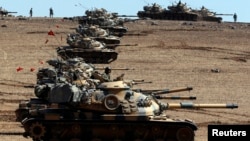The Syrian Foreign Ministry has expressed its opposition to the creation of a buffer zone along its northern border with Turkey.
Turkey has proposed the idea of a buffer zone -- which would almost certainly entail a no-fly zone patrolled by foreign peacekeepers inside Syria -- to provide a safe haven for displaced persons fleeing the Islamic State (IS) group's invasion of the Syrian town of Kobani on the Turkish border.
If IS succeeds in capturing Kobani, the humanitarian crisis will become more severe. Moreover, if IS overruns Kobani, it will control a border crossing and an important section of the Syria-Turkey border.
However, though the fighting in and around Kobani is still raging, Syria's Foreign Ministry said on October 15 that Damascus did not accept the proposals for a buffer zone and would "take in consultation with its friends all the necessary measures to preserve its national sovereignty and territorial integrity," according to Syrian state news agency SANA.
Some countries, particularly France, are in favor of a buffer zone, while the United States is more reluctant: U.S. deputy national security adviser Tony Blinken has said the idea is neither new nor "on the front burner."
Assad's key ally, Moscow, voiced its opposition to a buffer zone ahead of Damascus. On October 9, Russian Deputy Foreign Minister Aleksandr Lukashevich insisted that only the UN Security Council -- where Russia has a veto -- could take the decision to impose a buffer zone.
Lukashevich also suggested that the U.S.-led airstrikes had exacerbated the humanitarian crisis around Kobani, since -- as a result of the strikes -- IS militants had changed their tactics, placing their military units in populated areas and using civilians as human shields.
However, Damascus and its allies oppose a buffer zone for two main reasons: first, because it would certainly involve the deployment of foreign forces on Syrian soil; and second, because any no-fly zone could set a precedent of similar zones that would hamper the ability of the Syrian military, which relies heavily on air power, to combat rebels including the U.S.-backed Free Syrian Army.
As Blinken pointed out, the proposal of a buffer zone or no-fly zone inside Syria is not new. The idea of establishing "humanitarian corridors" on Syrian soil was put forward as early as 2012, as a way to avoid civilian casualties.
Moscow's opposition to such buffer zones is also not new: in mid-2013, Russia insisted it would not allow no-fly zones to be imposed over Syria.
-- Joanna Paraszczuk
